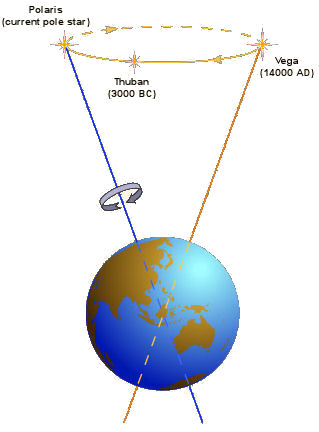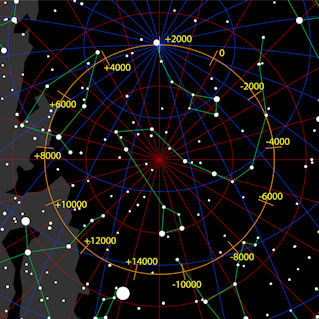Precession of the Equinox
The Earth wobbles in space like an out-of-balance top. Each full wobble takes about 25,765 years.
Because of the slow change in our orientation to the stars, the position of the Sun on the first the day of spring (the vernal equinox) slowly shifts westward around the sky, which also moves it around our calendar. That is why we refer to the effect as the precession of the equinox. The rate of the shift is 1 day every 71 years. The position of the Sun on the day of the vernal equinox is presently in the constellation of Pisces near the border of Aquarius. Modern star maps have the equinox entering Aquarius in about 600 years. The borders are arbitrary but popular culture and mysticism often refer to current times as the dawn of the "age of Aquarius," a time of peace and understanding. The concept of great ages associated with the position of the equinox is ancient, but the mysticism regarding the age of Aquarius is modern. Another effect of the Earth's precession is that the star nearest the north celestial pole changes over time. Our familiar north star today, Polaris, will return to the position of north star again around 27,800, but due to its own proper motion around the galaxy it will be farther away from the pole than the 5 degrees it is now. Back in 23,600 BC it was closer to the pole than it is now. From the start of the building of the Stonehenge monument around 3,800 BC, to well past the building of the great pyramids in Eqypt in 2500 BC, a star named Thuban in the constellation Draco would have been perceived as the north star. Around the stone-age mammoth-hunting time of 12,000 BC, the bright star Vega in the constellation Lyra was the north star, and will be again around the year 14,000 AD. Around 130 BC a greek astronomer named Hipparchus estimated the length of the cycle of Earth's precession by comparing his own observations to those recorded by Babylonian and Chaldean astronomers in the preceding centuries. The reason for the slow wobble is that the Earth is not a perfect sphere. If the Earth were a perfect sphere there would be no precession at all, but the equatorial diameter of the Earth is larger than the polar diameter. The radius of the Earth at the equator is 6378 km and at the poles it is 6356 km. Because of this and other asymmetries in the shape of the earth, gravitational forces from the Sun and Moon create torque on the axis. |

